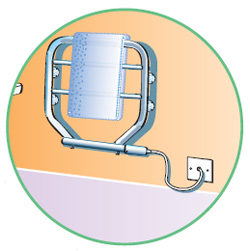Electric towel rails Supplementary equipotential bonding of an electric towel rail in a location containing a bath or shower may be provided by the circuit protective conductor in the flexible cord.

The Snag
A householder complained about the unsightly appearance of many green-andyellow protective conductors and BS 951 clamps in his bathroom.
An unnecessary supplementary bonding connection had been made to the customer’s recently installed electric towel rail.
Solution
It is usually not necessary to provide an additional supplementary bonding conductor connecting the metal body of the electric towel rail directly to the remainder of the extraneousconductive- parts and exposedconductive- parts in zones 1, 2 or 3 of the bathroom, even though in many cases a lug is provided.
The circuit protective conductor in the flexible cord often meets the requirements of BS 7671. Supplementary bonding may have to be provided from the earthing terminal in the connection unit to other circuits and extraneous-conductive-parts in the bathroom if required by Regulation 601-04-01.
Regulation 547-03-05
Where supplementary bonding is to be applied to a fixed appliance which is supplied via a short length of flexible cord from an adjacent connection unit or other accessory, incorporating a flex outlet, the circuit protective conductor within the flexible cord shall be deemed to provide the supplementary bonding connection to the exposedconductive- parts of the appliance, from the earthing terminal in the connection unit or other accessory.
Regulation 601-04-01(part of)
Local supplementary equipotential bonding complying with Regulation 547-03 shall be provided connecting together the terminal of the protective conductor of each circuit supplying Class I and Class II equipment in zones 1, 2 or 3, and extraneousconductive- parts in these zones.
The supplementary equipotential bonding may be provided in close proximity to the location.
